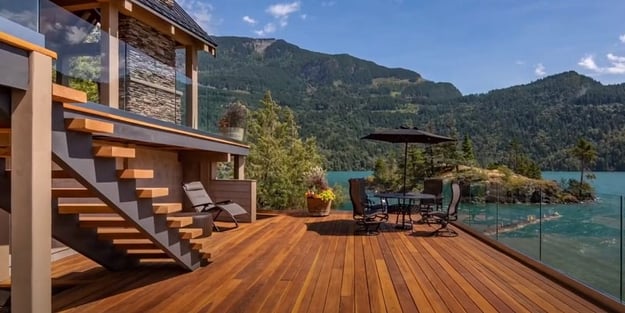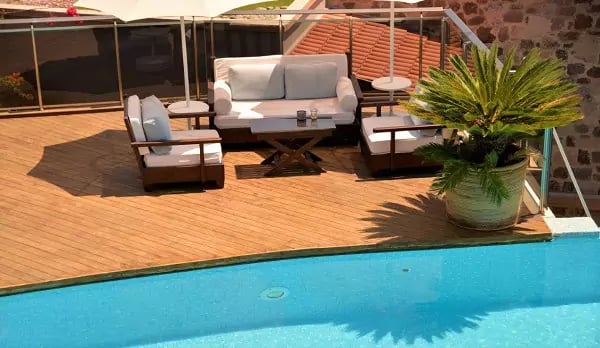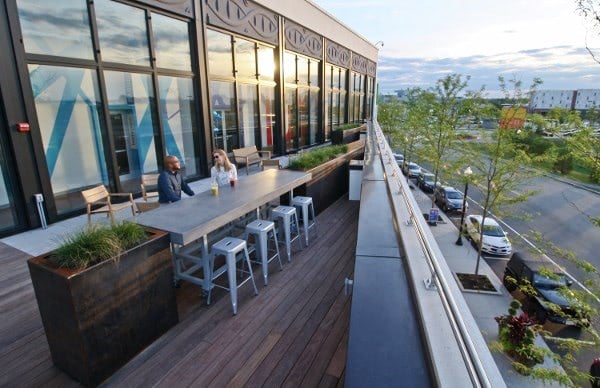
According to Google 300,000 paying customers just in the last year were looking for a rooftop bar in their area and 74,000 searched for rooftop dining. If your business wants a piece of that action but the planning and costs seem intimidating, these pro tips for building a rooftop deck can help.
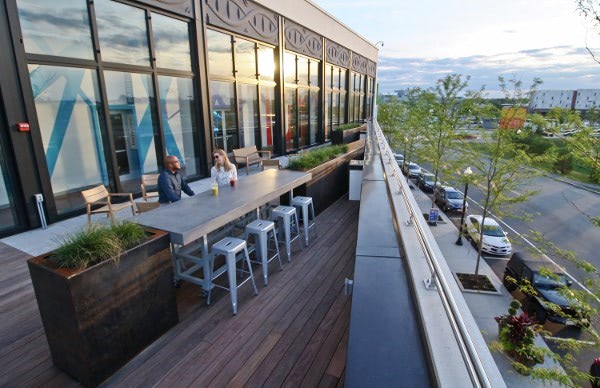 Rooftop hardwood deck with seating and a built in kitchen and bar area just outside floor to ceiling glass doors.
Rooftop hardwood deck with seating and a built in kitchen and bar area just outside floor to ceiling glass doors.
Why Build a Rooftop Patio at Your Restaurant or Bar?
Rooftop decks in restaurants, hotels and bars were already a big attraction prior to 2020. Then, with the chaos of the pandemic, suddenly owners had to find outdoor dining space to survive. For a lot of urban-based businesses there was nowhere to build but UP. Let's talk about two important factors: Designing your rooftop deck and the best way to build one to increase its long term return on investment.
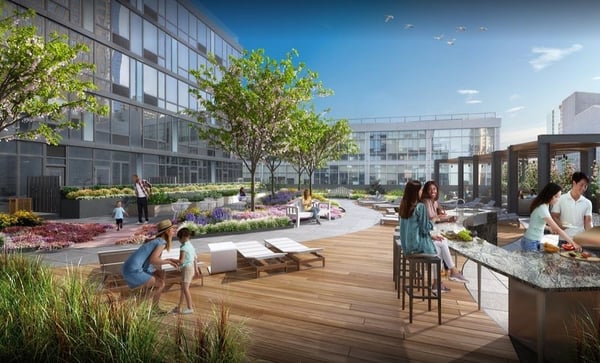
An architect's rendering of a planned commercial hardwood rooftop deck for entertaining and relaxing.
Those hotels, restaurants, events spaces and bars that have already added a rooftop ding area continue to have the competitive edge. The hospitality industry experts foresee people wanting to continue drinking and dining al fresco more frequently and more places.
“For many restaurants, we’re entering not just a new normal but a ‘next normal,’ … likely to include more outdoor dining as customers get used to enjoying their meals al fresco. Smart restaurants will embrace their outdoor spaces by making them smarter and more inviting for diners now and when the pandemic is far in the past.” - @@Modern Restaurant Management
Understandably the idea, and investment, of adding a well-made rooftop deck might be intimidating at first. With the right materials, however, rooftop patio areas can be low maintenance and avoid showing wear quickly. Make smart choices about quality and durability and the long-term value can quickly recoup that upfront cost. (Without sacrificing luxurious and attractive aesthetics!)
Related: Check out the rooftop deck design and planning videos on our YouTube channel
What to know before building your rooftop deck
Imagining the final design for your rooftop is the exciting end goal. But the preliminary steps are even more important.
Safety first. Basic items to check off the list before you start designing.
These first two questions must be answered before you start planning:
-
Is a rooftop deck allowed in my area?
Many cities, neighborhoods, historic areas and even building associations have requirements surrounding rooftop decks. Start with your local building department and go from there.
- Can my rooftop support additional weight from a rooftop deck?
Rooftops and buildings are not all equal. From a safety and liability perspective alone you will want to get all your load maximum information since you will have a crowd using this space. Overloaded decks not built with the correct support and collapse are the cause of hundreds of injuries and even deaths per year. No one wants to be part of that statistic.
It will also affect what kind of decking and deck system, features, and heavy load items (like bars and hot tubs) can be safely added to your design. Start with your local building code official and a structural engineer. An architect experienced in rooftop decks can help.
Related: More Pro Tips On Safely Planning and Building A Rooftop Deck
Designing Your Rooftop Deck
Adding Rooftop Dining
A great example of good planning and material choice is Matunuck Oyster Bar, a popular seafood restaurant on the Rhode Island shore. The owners and design team planned a stable and functional rooftop deck on a tight schedule for reopening in the summer of 2020.
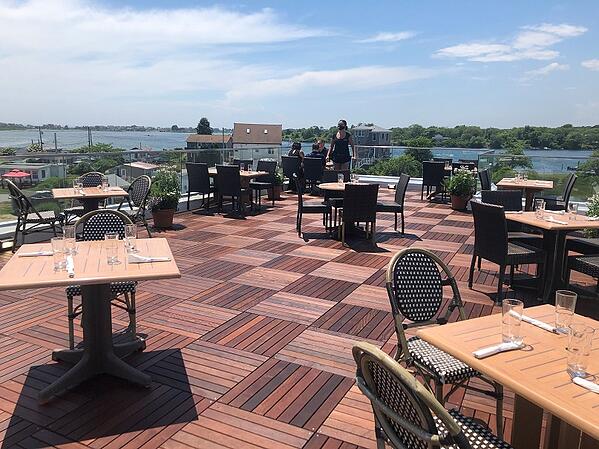 The completed Matunuck Oytser Bar rooftop dining area.
The completed Matunuck Oytser Bar rooftop dining area.
“When the Matunuck Oyster Bar needed additional space to seat their clients, they went straight up to the roof. An unused portion of their existing roof was evaluated by an engineer, and it met all the structural requirements for a rooftop deck. It transformed an otherwise wasted space and provides seating and a great view of the bay and surrounding area. Game on.” - "Delicious Rooftop Deck at Rhode Island Restaurant"
.jpg?width=598&height=187&name=Eurotec%20Adjustable%20pedestals%20and%20Aluminum%20system%20profiles%20-%20Copy%20(1).jpg) Matunuck Oyster Bar rooftop deck with aluminum components laid down on the prepared rooftop.
Matunuck Oyster Bar rooftop deck with aluminum components laid down on the prepared rooftop.
This restaurant project used the Eurotec Rooftop Deck System, an innovative rooftop deck foundation. Custom Ipe wood deck tiles were specified for this project. The reasons for these choices were plentiful.
- Eurotec aluminum components will not rot like wood sleepers, even when bombarded with salt spray and storms over years.
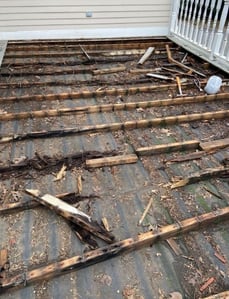
Avoid this headache! An example of rotted wood sleepers under another rooftop deck that was replaced with Eurotec and hardwood decking.
- Through-roof hold downs were added, which were fastened to the aluminum system framework to meet or exceed the hurricane wind-zone performance for the New England coastline.
- The Eurotec raised pedestals and rails allow water to flow out from under the deck freely. This avoids trapped moisture that prevents rot under the deck and on the rooftop.
- Ipe hardwood has the highest natural fiber density of all exotic hardwoods, the gold standard for natural rot and insect damage resistance. Ipe hardwood shows incredibly little wear and tear from heavy foot traffic and furniture, lowering maintenance.
- The custom Ipe deck squares are made to remove as needed for repairs under the deck. The tiles also allow spilled food and liquids to be cleaned and washed away from on, and under, the rooftop dining area. A hygienic and well-planned design.
- Created much needed outdoor dining space from of wasted roof space (versus an outdoor tent and plastic tables and chairs in the parking lot). The rooftop deck has decades of outdoor dining potential for their guests and their business, so the return on investment is expected to be high.
Explore more! Download your copy of the Rooftop Deck Design Idea Portfolio here.
Designing a Rooftop Patio with a Bar
Design ideas for a rooftop entertainment space are limitless. No matter where you are located, a deck designer or architect can complement your brand, and take full advantage of your location. Here are a few ideas to start you thinking.
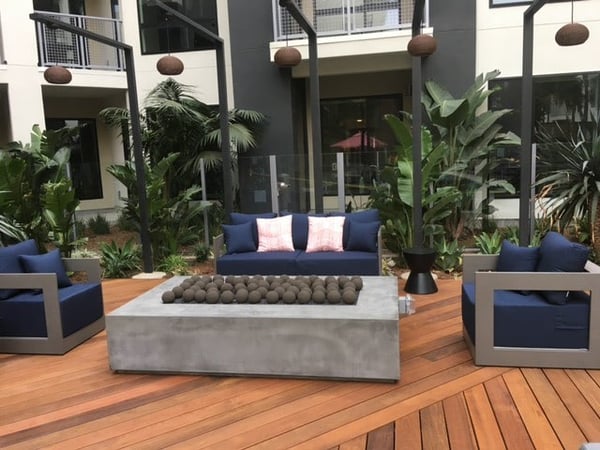
Ipe decking is laid out in diagonals to add visual space and interest to a small rooftop deck space. Plush seating, a firepit, and some tropical landscaping give it an oasis feel in a modern setting, without needing an expansive (or expensive) size space.
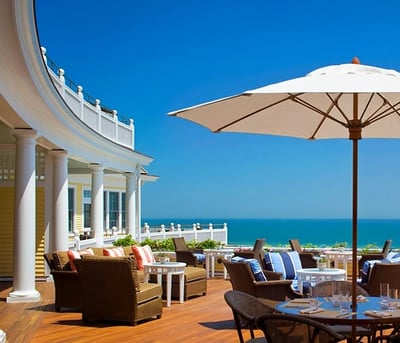
By the sea! This incredible landmark inn on the northeastern shoreline has several heights of balcony and rooftop deck spaces along the guest room floors, dining, and common areas. These are also Ipe wood. The rooftop patios are designed to blend with the architecture of the historic inn while maintaining their structural strength and longevity.
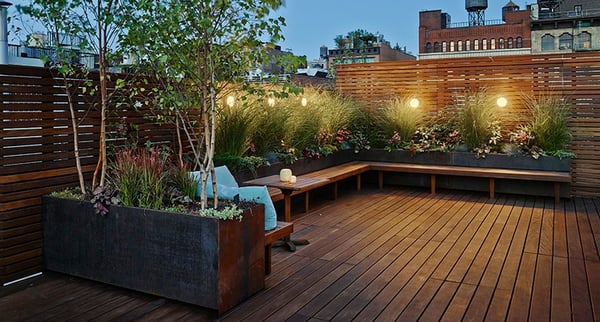
Good vibes only. Two views of the same rooftop space. All hardwood decking, seating, greenery planters and even privacy walls contrast nicely with the industrial New York City backdrop. Using sustainable hardwood decking creates a low maintenance, high profile, and gorgeous space for guests.
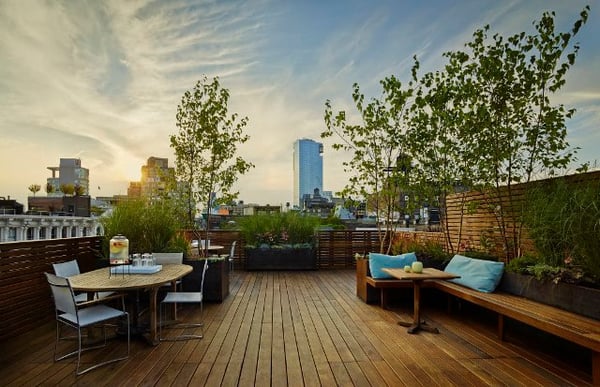
Ready for more? Grab your copy of the Rooftop Deck Project Portfolio for more information.
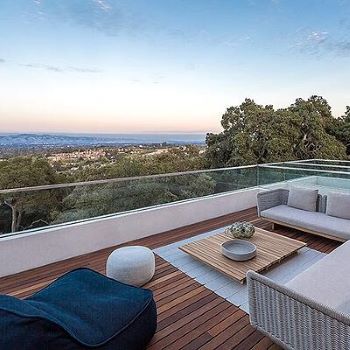 Adding a rooftop patio that leverages your fantastic location - city or country - is a great idea. If your view is currently behind small windows - or walls - consider adding a rooftop balcony patio or deck here that takes full advantage of this competitive edge for your business.
Adding a rooftop patio that leverages your fantastic location - city or country - is a great idea. If your view is currently behind small windows - or walls - consider adding a rooftop balcony patio or deck here that takes full advantage of this competitive edge for your business.
Related: Is A Rooftop Deck Worth The Investment?
Planning a Rooftop Event Space
Rooftops are big for weddings, celebrations, corporate events. If you are considering creating or extending event space, a rooftop deck could be the way to go for you.
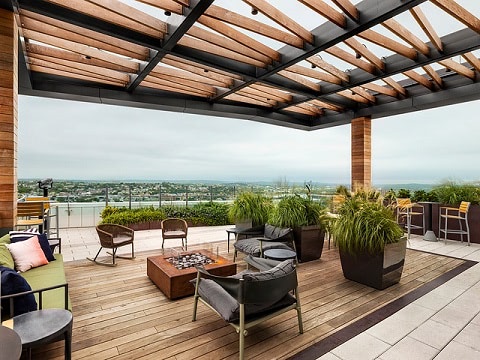 The dark and light hardwood decking layout and artful pergola with stacked columns was all from hardwood decking materials. Contrasted with the stone paver areas, this deck is designed to create a central gathering place with pub height tables around the edges for more privacy.
The dark and light hardwood decking layout and artful pergola with stacked columns was all from hardwood decking materials. Contrasted with the stone paver areas, this deck is designed to create a central gathering place with pub height tables around the edges for more privacy.
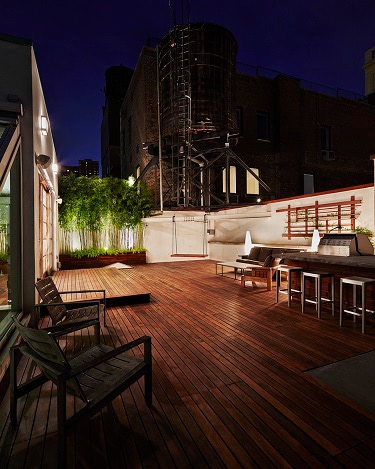 Short on space? Rooftop decks can be a wonderful way to add a little square footage for a LOT of impact. Here, the industrial chic of this penthouse space is softened and updated with hardwood decking. Check out the whimsical wood swing, planters, wall-hanging arbor, and wrapped bar front.
Short on space? Rooftop decks can be a wonderful way to add a little square footage for a LOT of impact. Here, the industrial chic of this penthouse space is softened and updated with hardwood decking. Check out the whimsical wood swing, planters, wall-hanging arbor, and wrapped bar front.
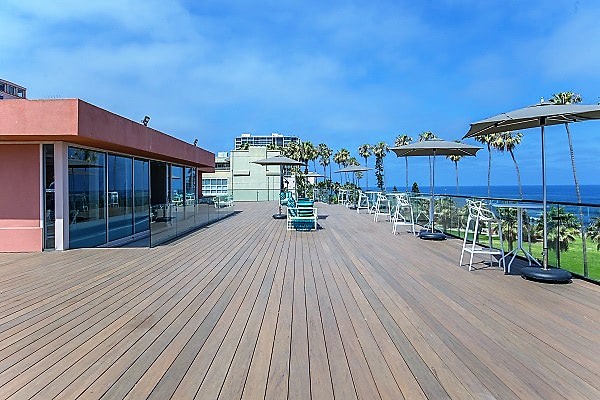 This hotel in Southern California chose the Eurotec Rooftop Deck System to withstand the salt air and storms possible along the West Coast shore for its rooftop event space.
This hotel in Southern California chose the Eurotec Rooftop Deck System to withstand the salt air and storms possible along the West Coast shore for its rooftop event space.
Related: Renewed Rooftop Deck Crowns Hotel
What Types of Wood Decking Are Best on A Rooftop?
Rooftop decks are a special breed of deck. Rooftops get stronger UV exposure than ground level decks. Rooftop decks also get full exposure to all weather conditions, meaning they are going to take more than their fair share of bulk water from storm and melting snow.
For these reasons, rooftop decking made with the wrong materials will require more everyday maintenance, repairs, and down time of your deck area. All costly for your business.
So How Often Do Rooftop Decks Need to Be Replaced (or repaired?)
An important factor in how long your rooftop deck will last is the decking material you choose and how your rooftop deck is installed.
Quality and durability are key here. For example, stone pavers can chip. Some wood decking can become scratched and splinter with use and UV exposure. Stained and painted decking can fade in sections, leaving ugly patches.
Related: The Best Rooftop Deck System for Wood Decks
To prevent high maintenance situations, choose your decking material wisely.
Rooftop decking made with these woods will require more in everyday maintenance, repairs. and down time of your deck area, all costly for your business.
Decking materials to avoid for rooftop decks:
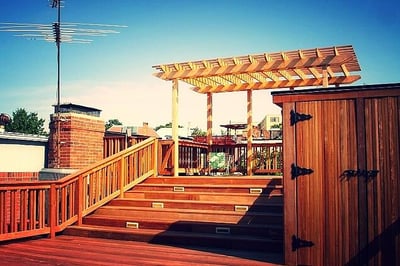
Composite decking on a rooftop - you can see where the pergola, railing and top steps have already faded to a different color than the rest of the boards. Composite is not suggested for rooftop patio use for this and other reasons.
- Composites and synthetic decking offer many color options, do not require refinishing, and are available in a range of quality and prices. The deck boards are moisture resistant and insect resistant. But these materials are mostly PVC plastic and resins which warp and fade faster in the heat and sun than other decking available. These can also crack and chip with wear, increasing repairs.
- Lower density woods (softwoods) such as Redwood and Western Red Cedar are beautiful and iconic but not recommended for rooftop decks. The lower density fiber strength and higher porousness of these wood materials make them more susceptible to rot, mold, and even insect damage.
With the right care, softwoods are appropriate for ground level decking. For rooftop decking, especially with heavy wear, everyday maintenance needs are much higher. Refinishing would be more frequent. If allowed to weather to gray, the resistance to moisture damage and insects is lowered and maintenance is increased.
- Stone pavers are good looking, can be laid out in interesting patterns, and come in many colors and natural looking shades. They are insect and water resistant. They contrast nicely with wood decking.
However, cracking, chips, breakage, and fading are real threats from heavy foot traffic and moving furniture. Stone and concrete cannot be easily repaired or individually replaced. Another factor to consider is the weight they add to your overall rooftop plan.
So, Can You Find a No Maintenance Decking for a Rooftop?
The short answer is no, but you can get really close. All decking will need proper cleaning as needed, just like your interior flooring.
- All types of decking can suffer damage from high UV exposure, storm debris, or heavy wear and tear from furniture and foot traffic to some extent. And not all decking will perform equally well.
- Look for the strongest, most durable natural wood decking your budget allows for the easiest care and longest lasting rooftop patio.
- The naturally harder and more durable the wood decking, the less maintenance and refinishing needed. (Even if you want you plan to let it naturally weather to gray).
Here are the top materials to consider:
Excellent decking material choices for rooftop decks
Hardwood Decking
All premium hardwood decking requires no painting, sealing, or refinishing. A UV protectant oil is suggested to keep the natural colors looking like new. Or hardwoods can be allowed to weather resulting in a satiny silver-gray patina. Hardwoods have high fiber density that creates high resistance to rot, mold, decay, and insect damage naturally. Types of hardwood decking are:
Ipe Wood: Ipe is the highest fiber density of all exotic hardwoods and the top-rated hardwood for durability, longevity, and strength. Highest resistance to insects, rot, mold and decay of all the hardwoods. Highly resistant to scratches, gouges, and foot. If wear occurs on deck boards over time it can be sanded out instead of replaced. Ipe is higher priced and availability is lower than other hardwoods, but the quality is worth it since it is tested and proven to last over 20 years. The return on investment is high!
Ipe is known for its medium to dark brown color range and gorgeous grain patterns.
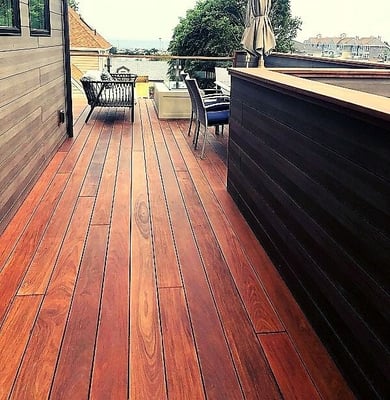
![]()
Brazilian Cherry (Jatoba): Brazilian Cherry is well known for interiors and fast becoming a favorite for exteriors. Brazilian Cherry is very hard and has high resistance to rot, mold, decay and insects. Its colors, durability, longevity make it a lower priced alternative, more readily available alternative to Ipe or Cedar. One unique feature is that Brazilian Cherry gets darker with sun exposure, eventually aging to silver gray if you let it.
This South American hardwood has natural light pink to salmon pink tones in its boards that deepen to dark reddish-brown over time and with UV exposure. It has a straight, fine grain.
.jpeg?width=300&height=400&name=Jatoba%20hardwood%20decking%20in%20Richmond%20Virginia%20(1).jpeg)
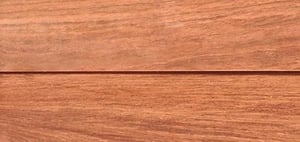
FSC Machiche Wood: This lesser-known hardwood option is getting more popular every year. Machiche has all the superior qualities of its fellow hardwoods. High resistance to rots, decay, mold, and insects and very high durability. Mataverde Machiche is FSC Certified.
Boasting a rich, chocolatey-to-coffee brown color range and grain and figuring that stands out on its own.
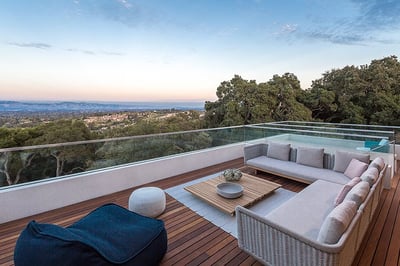
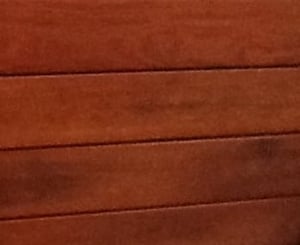
Garapa: Blonde decks have more fun! All the characteristics of hardwood, with high resistance to insects, rot, decay, and mold. Garapa is also the most affordable hardwood option, and less expensive than popular softwoods, for projects looking to meet budget criteria.
Light golden blonde to brown Garapa is a wonderful choice for a lighter colored deck that shows off unique figuring patterns in the deck boards.
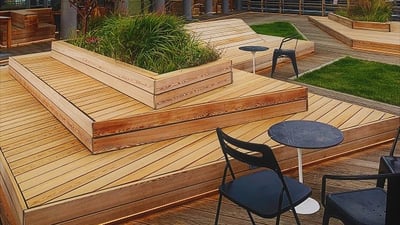
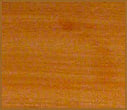
Cumaru: A frequent choice for high end deck projects, Cumaru, is a smart choice for rooftop decks. High resistance to insects, mold, and rot. Impressively good looks and grain patterns.
Cumaru is a beautiful mix of medium to dark brown colors.
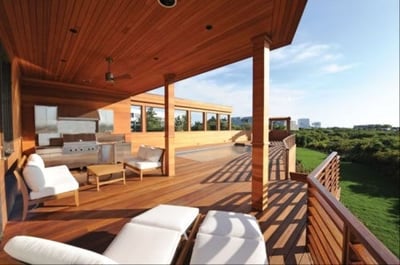
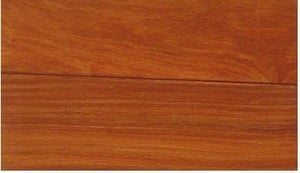
Related: "The Best Decking Material For Your Rooftop Project"
If hardwood doesn't fit your project needs, or you need something more budget friendly, consider a Thermally Modified wood.
Thermally Modified Wood
Mataverde thermally modified woods are a more budget-friendly standard wood species alternative to hardwoods that share comparable characteristics. Thermally Modified decking is wood that is treated with heat and steam in a pressure kiln. This scientific process is environmentally friendly, using no chemicals or toxins, and a more sustainable process. Thermal modification creates a more stable, and higher performing version of the original wood species. The processes also “cooks” the sugar out of the wood which is makes it unattractive to hungry insects. The process leaves the original species darker and the grain visually “pops” for an impressive and attractive look. These modified woods can be painted or stained, or left natural, and can be weathered to gray. They require much less maintenance and have higher resistance to water, rot, decay, mold than their untreated counterparts, too.
Thermowood: Made from modified Ash hardwood, Thermowood has good resistance to insects, moisture damage and decay. Lower density than exotic hardwoods, the domestic ASH hardwood is made stronger and more durable with thermal modification.
The color range varies from lighter brown to darker brown and shows off the grain pattern of Ash.
See the Thermowood Decking Picture Gallery Here
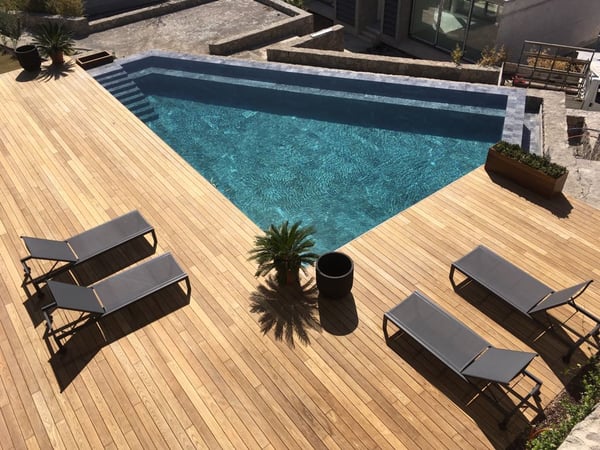
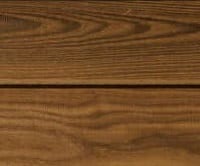
Thermawood: Made from Hemlock Fir softwood, Thermawood has good resistance to moisture decay and damage. The modification process gives it features and characteristics similar to hardwoods but I can be painted and stained. Also available in Fire Treated.
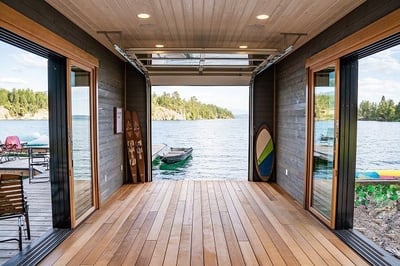
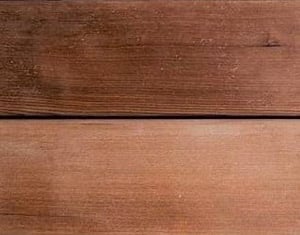
If this article has you thinking about adding that rooftop deck, we can help with first steps. Feel free to contact us with questions, pricing or sample requests for any of the products mentioned here. We are ready, and happy, to help.

Related Posts
